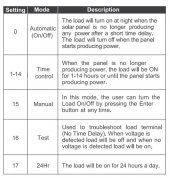I'm working on a project that uses the load pins on a cheapie Renogy 10 amp PWM charge controller to power a bilge pump for a minute an hour whenever the battery has sufficient power, but I can't find the rating of those load pins anywhere.
I'm using this charge controller if it matters (Renogy 10 amp PWM):
My pump pulls about 30 watts / 2.5 amps, and has been running well for a week so I'm guessing all is fine, but I'm posting my project to github and wanted to post the rating and limitation of the load pins. I know Renogy only has lights in mind as a use case, does anyone has a theory why?
Since the Renogy only lets me turn on the load pins at night I had to make my own controller using an ESP32 (similar to Arduino) that gets data from the charge controller via the RS232 port and then turns on the power pins when there's enough power in the day. Working great, and I'm posting the project to Github if anyone is interested:

 github.com
github.com
(That's just the base library I made, not the full project with the pump, but I'll be posting that soon. Post if you need it and I still haven't posted it.)
Here's a screenshot of the Renogy manual showing the built-in modes of the load pins:

That's pretty incomplete! Or rather oddly restricted to just lights.
I wonder if they're doing it so people don't connect non resistive loads. But still, people could connect a relay to power inductive loads directly from the charge controller, so seems like such a silly restriction. And furthermore I *think* a bilge pump is an inductive load, and it's working fine... So I guess I'm stumped. Maybe it's just taking awhile for the inductive kickback to damage the MOSFET on the controller.
I'm using this pump by the way:
The manual also says the controller will throw an error code if the power draw of the load switch reaches 105% of capacity, which is great, but it sure is odd that they don't tell us what that capacity is. I wonder if the reason is that the load is shared by the battery input and switch output. So for example if the 10 amp charge controller is providing 9 amps of power to the batteries, that leaves only 1 amp for the load switch. That would explain both why they don't mention the actual load, and why they only let us control the load at night. But still, it would be nice for them to mention that. And furthermore having options to control the load switch in the day would allow for someone to either have a large controller than their panel so daytime power wouldn't be an issue, or to just use a relay connected to the load switch.
I'm using this charge controller if it matters (Renogy 10 amp PWM):
My pump pulls about 30 watts / 2.5 amps, and has been running well for a week so I'm guessing all is fine, but I'm posting my project to github and wanted to post the rating and limitation of the load pins. I know Renogy only has lights in mind as a use case, does anyone has a theory why?
Since the Renogy only lets me turn on the load pins at night I had to make my own controller using an ESP32 (similar to Arduino) that gets data from the charge controller via the RS232 port and then turns on the power pins when there's enough power in the day. Working great, and I'm posting the project to Github if anyone is interested:
GitHub - wrybread/ESP32ArduinoRenogy: Reads data from a Renogy solar charge controller's RS232 port with an ESP32 or Arduino
Reads data from a Renogy solar charge controller's RS232 port with an ESP32 or Arduino - wrybread/ESP32ArduinoRenogy
(That's just the base library I made, not the full project with the pump, but I'll be posting that soon. Post if you need it and I still haven't posted it.)
Here's a screenshot of the Renogy manual showing the built-in modes of the load pins:

That's pretty incomplete! Or rather oddly restricted to just lights.
I wonder if they're doing it so people don't connect non resistive loads. But still, people could connect a relay to power inductive loads directly from the charge controller, so seems like such a silly restriction. And furthermore I *think* a bilge pump is an inductive load, and it's working fine... So I guess I'm stumped. Maybe it's just taking awhile for the inductive kickback to damage the MOSFET on the controller.
I'm using this pump by the way:
The manual also says the controller will throw an error code if the power draw of the load switch reaches 105% of capacity, which is great, but it sure is odd that they don't tell us what that capacity is. I wonder if the reason is that the load is shared by the battery input and switch output. So for example if the 10 amp charge controller is providing 9 amps of power to the batteries, that leaves only 1 amp for the load switch. That would explain both why they don't mention the actual load, and why they only let us control the load at night. But still, it would be nice for them to mention that. And furthermore having options to control the load switch in the day would allow for someone to either have a large controller than their panel so daytime power wouldn't be an issue, or to just use a relay connected to the load switch.
Last edited:


